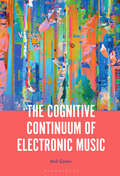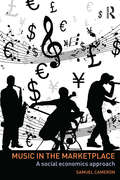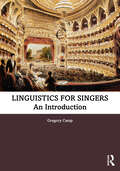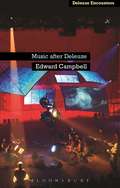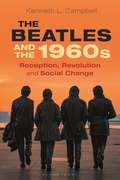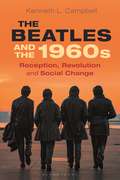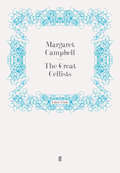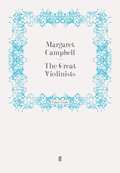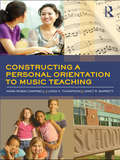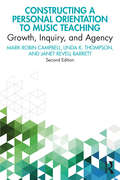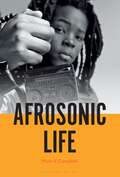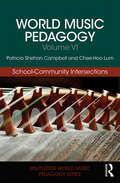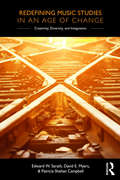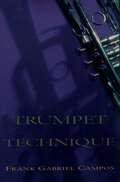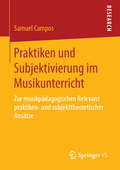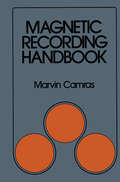- Table View
- List View
The Cognitive Continuum of Electronic Music
by Anil ÇamciThe electronic medium allows any audible sound to be contextualized as music. This brings about unique structural possibilities as spectrum, dynamics, space, and time become continuous dimensions of musical articulation. What we hear in electronic music ventures beyond what we traditionally characterize as musical sound and challenge our auditory perception on the one hand and our imagination on the other. Based on an extensive listening study conducted over four years, this book offers a comprehensive analysis of the cognitive processes involved in the experience of electronic music. It pairs artistic practice with theories from a range of disciplines to communicate how this music operates on perceptual, conceptual, and affective levels. Looking at the common and the divergent ways in which our minds respond to electronic sound, the book investigates how we build narratives from of our experience of electronic music and how we situate ourselves in them.
Music in the Marketplace: A social economics approach
by Samuel CameronMuch recent economic work on the music industry has been focused on the impact of technology on demand, with predictions being made of digital copyright infringement leading to the demise of the industry. In fact, there have always been profound cyclical swings in music media sales owing to the fact that music always has been, and continues to be, a discretionary purchase. This entertaining and accessible book offers an analysis of the production and consumption of music from a social economics approach. Locating music within the economic analysis of social behaviour, this books guides the reader through issues relating to production, supply, consumption and trends, wider considerations such as the international trade in music, and in particular through divisions of age, race and gender. Providing an engaging overview of this fascinating topic, this book will be of interest and relevance to students and scholars of cultural economics, management, musicology, cultural studies and those with an interest in the music industry more generally.
Music in the Marketplace: A social economics approach
by Samuel CameronMuch recent economic work on the music industry has been focused on the impact of technology on demand, with predictions being made of digital copyright infringement leading to the demise of the industry. In fact, there have always been profound cyclical swings in music media sales owing to the fact that music always has been, and continues to be, a discretionary purchase. This entertaining and accessible book offers an analysis of the production and consumption of music from a social economics approach. Locating music within the economic analysis of social behaviour, this books guides the reader through issues relating to production, supply, consumption and trends, wider considerations such as the international trade in music, and in particular through divisions of age, race and gender. Providing an engaging overview of this fascinating topic, this book will be of interest and relevance to students and scholars of cultural economics, management, musicology, cultural studies and those with an interest in the music industry more generally.
Linguistics for Singers: An Introduction
by Gregory CampLinguistics for Singers: An Introduction is a textbook and manual that provides singers with a foundation in linguistic features of four major singing languages—English, Italian, French, and German—and shows how these features can be used to inform vocal performance and interpretation. Going beyond the basics of lyric diction, a grounding in linguistics enables student musicians to understand language holistically and more fully comprehend the music they are learning. The comparative approach to four common languages allows readers to readily grasp similarities and apply principles across vocal repertoire. Beginning with the sounds of a language and gradually moving up through larger levels of linguistic structure, from words to full texts, the chapters illustrate concepts using real examples from art songs and opera. The clear explanations enable readers new to linguistics to connect these concepts with their own musical practice. Designed for flexible use in courses on language and singing, lyric diction, repertoire studies, and collaborative piano, this book provides a vital resource for singers, vocal instructors, and conductors.
Linguistics for Singers: An Introduction
by Gregory CampLinguistics for Singers: An Introduction is a textbook and manual that provides singers with a foundation in linguistic features of four major singing languages—English, Italian, French, and German—and shows how these features can be used to inform vocal performance and interpretation. Going beyond the basics of lyric diction, a grounding in linguistics enables student musicians to understand language holistically and more fully comprehend the music they are learning. The comparative approach to four common languages allows readers to readily grasp similarities and apply principles across vocal repertoire. Beginning with the sounds of a language and gradually moving up through larger levels of linguistic structure, from words to full texts, the chapters illustrate concepts using real examples from art songs and opera. The clear explanations enable readers new to linguistics to connect these concepts with their own musical practice. Designed for flexible use in courses on language and singing, lyric diction, repertoire studies, and collaborative piano, this book provides a vital resource for singers, vocal instructors, and conductors.
Music After Deleuze (Deleuze Encounters)
by Edward CampbellMusic After Deleuze explores how Deleuzian concepts offer interesting ways of thinking about a wide range of musics. The concepts of difference, identity and repetition offer novel approaches to Western art music from Beethoven to Boulez and Bernhard Lang as well as jazz improvisation, popular and sacred music. The concepts of the 'rhizome', the 'assemblage' and the 'refrain' enable us to think of the specificity of musical works as the meeting of productive forces, for example in the contemporary opera of Dusapin and the experimental music theatre of Aperghis. The concepts of smooth and striated space form the starting point for musical and political reflections on pitch in Western and Eastern music. Deleuze's notion of time as multiple illumines the distinctive conceptions of musical time found in Debussy, Messiaen, Boulez, Carter and Grisey. Finally, the innovative semiotic theory forged in Deleuze-Guattarian philosophy offers valuable insights for a semiotics capable of engaging with the innovative, molecular music of Lachenmann, Aperghis and Levinas.
Music After Deleuze (Deleuze Encounters)
by Edward CampbellMusic After Deleuze explores how Deleuzian concepts offer interesting ways of thinking about a wide range of musics. The concepts of difference, identity and repetition offer novel approaches to Western art music from Beethoven to Boulez and Bernhard Lang as well as jazz improvisation, popular and sacred music. The concepts of the 'rhizome', the 'assemblage' and the 'refrain' enable us to think of the specificity of musical works as the meeting of productive forces, for example in the contemporary opera of Dusapin and the experimental music theatre of Aperghis. The concepts of smooth and striated space form the starting point for musical and political reflections on pitch in Western and Eastern music. Deleuze's notion of time as multiple illumines the distinctive conceptions of musical time found in Debussy, Messiaen, Boulez, Carter and Grisey. Finally, the innovative semiotic theory forged in Deleuze-Guattarian philosophy offers valuable insights for a semiotics capable of engaging with the innovative, molecular music of Lachenmann, Aperghis and Levinas.
The Beatles and the 1960s: Reception, Revolution, and Social Change
by Kenneth L. CampbellThe Beatles are widely regarded as the foremost and most influential music band in history and their career has been the subject of many biographies. Yet the band's historical significance has not received sustained academic treatment to date. In The Beatles' Reception in the 1960s, Kenneth L. Campbell uses the Beatles as a lens through which to explore the sweeping, panoramic history of the social, cultural and political transformations that occurred in the 1960s. It draws on audience reception theory and untapped primary source material, including student newspapers, to understand how listeners would have interpreted the Beatles' songs and albums not only in Britain and the United States, but also globally. Taking a year-by-year approach, each chapter analyses the external influences the Beatles absorbed, consciously or unconsciously, from the culture surrounding them. Some key topics include race relations, gender dynamics, political and cultural upheavals, the Vietnam War and the evolution of rock music and popular culture. The book will also address the resurgence of the Beatles' popularity in the 1980s, as well as the relevance of The Beatles' ideals of revolutionary change to our present day.This is essential reading for anyone looking for an accessible yet rigorous study of the historical relevance of the Beatles in a crucial decade of social change.
The Beatles and the 1960s: Reception, Revolution, and Social Change
by Kenneth L. CampbellThe Beatles are widely regarded as the foremost and most influential music band in history and their career has been the subject of many biographies. Yet the band's historical significance has not received sustained academic treatment to date. In The Beatles' Reception in the 1960s, Kenneth L. Campbell uses the Beatles as a lens through which to explore the sweeping, panoramic history of the social, cultural and political transformations that occurred in the 1960s. It draws on audience reception theory and untapped primary source material, including student newspapers, to understand how listeners would have interpreted the Beatles' songs and albums not only in Britain and the United States, but also globally. Taking a year-by-year approach, each chapter analyses the external influences the Beatles absorbed, consciously or unconsciously, from the culture surrounding them. Some key topics include race relations, gender dynamics, political and cultural upheavals, the Vietnam War and the evolution of rock music and popular culture. The book will also address the resurgence of the Beatles' popularity in the 1980s, as well as the relevance of The Beatles' ideals of revolutionary change to our present day.This is essential reading for anyone looking for an accessible yet rigorous study of the historical relevance of the Beatles in a crucial decade of social change.
The Great Cellists (Great Musicians #1)
by Margaret CampbellThe Great Cellists is a comprehensive and authoritative history of the lives and work of the cello's great performers and teachers, from the emergence of the solo instrument in the seventeenth century to the present day.In its early history, the cello was a genuine 'bass' violin that came in three sizes and from the thirteenth century was played side by side with viols and later violins. The instrument we know today came into general use by the time the great makers of the seventeenth and eighteenth centuries - such as Amati, Stradivari and Guarneri - brought their craft to perfection and made numerous of the instruments most sought after by today's virtuosi.Many of the earliest known professional cellists were employed as court musicians, but their names have not been widely known. The most familiar names belong to those early cellists who were also composers: Boccherini, Romberg, Piatti and Popper. In more recent times, the great Europeans Becker, Klengel and Salmond led to Feuermann, Piatogorsky, Fournier, Rostropovich, and above all to Casals; and they, in turn, have greatly influenced contemporary musicians such as the late Jacqueline du Pr� and the manifold brilliant players from Russia, Japan and the USA. The Great Cellists reveals a splendid range of personalities from the conventional to the eccentric. Included also are the numerous less well-known cellists who were important as founders of the various national 'schools'.Margaret Campbell has interviewed many eminent musicians and had rich access to letters and private documents in her coverage of the last hundred years. Her absorbing book presents to the reader a rich vision of skills and traditions that have been handed down nationally through the generations, and developed internationally since the twentieth century. It is a book for string players, students, concertgoers and CD buffs - indeed, anyone who enjoys the sound of the cello.
The Great Violinists (Great Musicians #2)
by Margaret CampbellThis carefully researched and definitive book recreates the magic of the greatest violinists in history. In three centuries, the solo performer progressed from downtrodden private servant to revered public idol. The supreme artists Corelli, Vivaldi, Viotti, Paganini, Vieuxtemps, Joachim and Auer were pivotal figures in the history of violin playing, while more recent times have seen Sarasate, Ysaye and the virtuosi of the modern recording era. The Great Violinists reveals a range of personalities from the conventional to the eccentric. In her coverage of the last hundred years, Margaret Campbell has interviewed many eminent musicians and had rich access to letters and private documents. Her book offers a vivid portrait of skills and traditions that have been handed down through generations. It is a book for string players, students, concert goers and music buffs - indeed, anyone who enjoys the sound of the violin.
Constructing a Personal Orientation to Music Teaching
by Mark Robin Campbell Linda K Thompson Janet R. BarrettConstructing a Personal Orientation to Music Teaching promotes inquiry and reflection to facilitate teacher growth, lifelong learning and a disposition toward educational change. Strongly grounded in current theories and research in teacher education, the text engages readers in analyzing their own experiences in order to conceptualize the complexity of teaching; involves them in clarifying their reasons for seeking a career in teaching; supports their insights, questions, and reflections about their work; and promotes a reflective, critical attitude about schools in general as teachers are urged to think of themselves as change agents in school settings.
Constructing a Personal Orientation to Music Teaching
by Mark Robin Campbell Linda K Thompson Janet R. BarrettConstructing a Personal Orientation to Music Teaching promotes inquiry and reflection to facilitate teacher growth, lifelong learning and a disposition toward educational change. Strongly grounded in current theories and research in teacher education, the text engages readers in analyzing their own experiences in order to conceptualize the complexity of teaching; involves them in clarifying their reasons for seeking a career in teaching; supports their insights, questions, and reflections about their work; and promotes a reflective, critical attitude about schools in general as teachers are urged to think of themselves as change agents in school settings.
Constructing a Personal Orientation to Music Teaching: Growth, Inquiry, and Agency
by Mark Robin Campbell Linda K. Thompson Janet Revell BarrettConstructing a Personal Orientation to Music Teaching: Growth, Inquiry, and Agency, (Second Edition), is a textbook for studies in music education. Expanding upon the first edition, the authors promote inquiry and reflection to facilitate teacher growth, lifelong learning, and a disposition toward educational change. The revised text responds to current calls for social change and teacher education reform by reaffirming and intensifying the need for music teachers to adopt a personal orientation toward their work. A personal orientation encourages teachers to initiate their own growth, engage in inquiry, and exercise agency in school contexts. Strongly grounded in current theories and research in teacher education, Constructing a Personal Orientation to Music Teaching: Growth, Inquiry, and Agency strives to do the following: Engage readers in analyzing their own experiences in order to conceptualize the complexity of teaching Involve them in clarifying their reasons for seeking a career in teaching Support their insights, questions, and reflections about their work Promote a reflective, critical attitude about schools in general as music teachers are urged to think of themselves as change agents in school settings Construct a moral purpose as a compass to guide their current and future endeavors in the profession. Every chapter includes a wealth of pedagogical features, including new methodologies and examples of practice to engage the readers in processes of inquiry and reflection. The second edition is organized in two parts. Part I focuses on positioning music teachers as learners in the profession, significantly expanding concepts explored in the first edition that are central to a personal orientation to professional growth. In the new edition, a reconceptualized Chapter 5 challenges teachers to cultivate their identities as change agents. The second half of the book—focusing on becoming a student of music teaching— features five new chapters. A provocative chapter on curriculum sets the stage for a set of additional chapters that invite deeper considerations of the commonplaces of teacher, learners, subject matter, and context. An epilogue speaks directly to the power of agency, imagination, and hope in teachers’ lives.
Constructing a Personal Orientation to Music Teaching: Growth, Inquiry, and Agency
by Mark Robin Campbell Linda K. Thompson Janet Revell BarrettConstructing a Personal Orientation to Music Teaching: Growth, Inquiry, and Agency, (Second Edition), is a textbook for studies in music education. Expanding upon the first edition, the authors promote inquiry and reflection to facilitate teacher growth, lifelong learning, and a disposition toward educational change. The revised text responds to current calls for social change and teacher education reform by reaffirming and intensifying the need for music teachers to adopt a personal orientation toward their work. A personal orientation encourages teachers to initiate their own growth, engage in inquiry, and exercise agency in school contexts. Strongly grounded in current theories and research in teacher education, Constructing a Personal Orientation to Music Teaching: Growth, Inquiry, and Agency strives to do the following: Engage readers in analyzing their own experiences in order to conceptualize the complexity of teaching Involve them in clarifying their reasons for seeking a career in teaching Support their insights, questions, and reflections about their work Promote a reflective, critical attitude about schools in general as music teachers are urged to think of themselves as change agents in school settings Construct a moral purpose as a compass to guide their current and future endeavors in the profession. Every chapter includes a wealth of pedagogical features, including new methodologies and examples of practice to engage the readers in processes of inquiry and reflection. The second edition is organized in two parts. Part I focuses on positioning music teachers as learners in the profession, significantly expanding concepts explored in the first edition that are central to a personal orientation to professional growth. In the new edition, a reconceptualized Chapter 5 challenges teachers to cultivate their identities as change agents. The second half of the book—focusing on becoming a student of music teaching— features five new chapters. A provocative chapter on curriculum sets the stage for a set of additional chapters that invite deeper considerations of the commonplaces of teacher, learners, subject matter, and context. An epilogue speaks directly to the power of agency, imagination, and hope in teachers’ lives.
Afrosonic Life
by Mark V. CampbellAfrosonic Life explores the role sonic innovations in the African diaspora play in articulating methodologies for living the afterlife of slavery. Developing and extending debates on Afrosonic cultures, the book attends to the ways in which the acts of technological subversion, experimentation and production complement and interrupt the intellectual project of modernity. Music making processes such as dub, turntablism, hip-hop dj techniques and the remix, innovate methods of expressing subjecthoods beyond the dominant language of Western “Man” and the market. These sonic innovations utilize sound as a methodology to institute a rehumanizing subjectivity in which sound dislodges the hierarchical ordering of racial schemas. Afrosonic Life is invested in excavating and elaborating the nuanced and novel ways of music making and sound creation found in the African diaspora.
Afrosonic Life
by Mark V. CampbellAfrosonic Life explores the role sonic innovations in the African diaspora play in articulating methodologies for living the afterlife of slavery. Developing and extending debates on Afrosonic cultures, the book attends to the ways in which the acts of technological subversion, experimentation and production complement and interrupt the intellectual project of modernity. Music making processes such as dub, turntablism, hip-hop dj techniques and the remix, innovate methods of expressing subjecthoods beyond the dominant language of Western “Man” and the market. These sonic innovations utilize sound as a methodology to institute a rehumanizing subjectivity in which sound dislodges the hierarchical ordering of racial schemas. Afrosonic Life is invested in excavating and elaborating the nuanced and novel ways of music making and sound creation found in the African diaspora.
World Music Pedagogy, Volume VI: School-community Intersections (Routledge World Music Pedagogy Series)
by Patricia Shehan Campbell Chee Hoo LumWorld Music Pedagogy, Volume VI: School-Community Intersections provides students with a resource for delving into the meaning of "world music" across a broad array of community contexts and develops the multiple meanings of community relative to teaching and learning music of global and local cultures. It clarifies the critical need for teachers to work in tandem with community musicians and artists in order to bridge the unnecessary gulf that often separates school music from the music of the world beyond school and to consider the potential for genuine collaborations across this gulf. The five-layered features of World Music Pedagogy are specifically addressed in various school-community intersections, with attention to the collaboration of teachers with local community artist-musicians and with community musicians-at-a-distance who are available virtually. The authors acknowledge the multiple routes teachers are taking to enable and encourage music learning in community contexts, such as their work in after-school academies, museums and libraries, eldercare centers, places of worship, parks and recreation centers, and other venues in which adults and children gather to learn music, make music, and become convivial through music This volume suggests that the world’s musical cultures may be found locally, can be tapped virtually, and are important in considerations of music teaching and learning in schools and community contexts. Authors describe working artists and teachers, scenarios, vignettes, and teaching and learning experiences that happen in communities and that embrace the role of community musicians in schools, all of which will be presented with supporting theoretical frameworks.
World Music Pedagogy, Volume VI: School-Community Intersections (Routledge World Music Pedagogy Series)
by Patricia Shehan Campbell Chee Hoo LumWorld Music Pedagogy, Volume VI: School-Community Intersections provides students with a resource for delving into the meaning of "world music" across a broad array of community contexts and develops the multiple meanings of community relative to teaching and learning music of global and local cultures. It clarifies the critical need for teachers to work in tandem with community musicians and artists in order to bridge the unnecessary gulf that often separates school music from the music of the world beyond school and to consider the potential for genuine collaborations across this gulf. The five-layered features of World Music Pedagogy are specifically addressed in various school-community intersections, with attention to the collaboration of teachers with local community artist-musicians and with community musicians-at-a-distance who are available virtually. The authors acknowledge the multiple routes teachers are taking to enable and encourage music learning in community contexts, such as their work in after-school academies, museums and libraries, eldercare centers, places of worship, parks and recreation centers, and other venues in which adults and children gather to learn music, make music, and become convivial through music This volume suggests that the world’s musical cultures may be found locally, can be tapped virtually, and are important in considerations of music teaching and learning in schools and community contexts. Authors describe working artists and teachers, scenarios, vignettes, and teaching and learning experiences that happen in communities and that embrace the role of community musicians in schools, all of which will be presented with supporting theoretical frameworks.
Redefining Music Studies in an Age of Change: Creativity, Diversity, and Integration
by Patricia Shehan Campbell Edward W. Sarath David E. MyersRedefining Music Studies in an Age of Change: Creativity, Diversity, Integration takes prevailing discourse about change in music studies to new vistas, as higher education institutions are at a critical moment of determining just what professional musicians and teachers need to survive and thrive in public life. The authors examine how music studies might be redefined through the lenses of creativity, diversity, and integration. which are the three pillars of the recent report of The College Music Society taskforce calling for reform. Focus is on new conceptions for existent areas—such as studio lessons and ensembles, academic history and theory, theory and culture courses, and music education coursework—but also on an exploration of music and human learning, and an understanding of how organizational change happens. Examination of progressive programs will celebrate strides in the direction of the task force vision, as well as extend a critical eye distinguishing between premature proclamations of “mission accomplished” and genuine transformation. The overarching theme is that a foundational, systemic overhaul has the capacity to entirely revitalize the European classical tradition. Practical steps applicable to wide-ranging institutions are considered—from small liberal arts colleges, to conservatory programs, large research universities, and regional state universities.
Redefining Music Studies in an Age of Change: Creativity, Diversity, and Integration
by Patricia Shehan Campbell Edward W. Sarath David E. MyersRedefining Music Studies in an Age of Change: Creativity, Diversity, Integration takes prevailing discourse about change in music studies to new vistas, as higher education institutions are at a critical moment of determining just what professional musicians and teachers need to survive and thrive in public life. The authors examine how music studies might be redefined through the lenses of creativity, diversity, and integration. which are the three pillars of the recent report of The College Music Society taskforce calling for reform. Focus is on new conceptions for existent areas—such as studio lessons and ensembles, academic history and theory, theory and culture courses, and music education coursework—but also on an exploration of music and human learning, and an understanding of how organizational change happens. Examination of progressive programs will celebrate strides in the direction of the task force vision, as well as extend a critical eye distinguishing between premature proclamations of “mission accomplished” and genuine transformation. The overarching theme is that a foundational, systemic overhaul has the capacity to entirely revitalize the European classical tradition. Practical steps applicable to wide-ranging institutions are considered—from small liberal arts colleges, to conservatory programs, large research universities, and regional state universities.
Trumpet Technique
by Frank Gabriel CamposIn the last forty years, many elite performers in the arts have gleaned valuable lessons and techniques from research and advances in sport science, psychomotor research, learning theory, and psychology. Numerous "peak performance" books have made these tools and insights available to athletes. Now, professor and performer Frank Gabriel Campos has translated this concept for trumpet players and other brass and wind instrumentalists, creating an accessible and comprehensive guide to performance skill. Trumpet Technique combines the newest research on skill acquisition and peak performance with the time-honored and proven techniques of master teachers and performers. All aspects of brass technique are discussed in detail, including the breath, embouchure, oral cavity, tongue, jaw, and proper body use, as well as information on performance psychology, practice techniques, musicians' occupational injuries, and much more. Comprehensive and detailed, Trumpet Technique is an invaluable resource for performers, teachers, and students at all levels seeking to move to the highest level of skill with their instrument.
Trumpet Technique
by Frank Gabriel CamposIn the last forty years, many elite performers in the arts have gleaned valuable lessons and techniques from research and advances in sport science, psychomotor research, learning theory, and psychology. Numerous "peak performance" books have made these tools and insights available to athletes. Now, professor and performer Frank Gabriel Campos has translated this concept for trumpet players and other brass and wind instrumentalists, creating an accessible and comprehensive guide to performance skill. Trumpet Technique combines the newest research on skill acquisition and peak performance with the time-honored and proven techniques of master teachers and performers. All aspects of brass technique are discussed in detail, including the breath, embouchure, oral cavity, tongue, jaw, and proper body use, as well as information on performance psychology, practice techniques, musicians' occupational injuries, and much more. Comprehensive and detailed, Trumpet Technique is an invaluable resource for performers, teachers, and students at all levels seeking to move to the highest level of skill with their instrument.
Praktiken und Subjektivierung im Musikunterricht: Zur musikpädagogischen Relevanz praktiken- und subjekttheoretischer Ansätze
by Samuel CamposAuf welche Weise konstituieren sich Subjekte im Musikunterricht? Die Studie nähert sich dieser Frage zunächst aus einer theoretischen Perspektive: Durch die Einnahme einer subjekt- und praktikentheoretischen Perspektive findet eine kritische Auseinandersetzung mit dem Begriff der Musikpraxis statt. Ausgehend von einer Analyse musikpädagogischer Praxisbegriffe erfolgt eine Rekonstruktion der mit ihnen jeweils verknüpften Subjektbegriffe. Vor dem Hintergrund poststrukturalistischer Ansätze eines „dezentrierten Subjekts“ wird schließlich eine subjekt- und praktikentheoretische Heuristik auf Musikpraxis entwickelt. Die Praktiken der Musikpraxis werden im empirischen Teil anhand einer Untersuchung von vier videografierten Unterrichtsszenen als Schauplatz von Subjektivierungsprozessen rekonstruiert. Musikpraxis wird als soziales Geschehen verstanden, in welchem sich Subjekte wechselseitig durch den konkreten Vollzug sozialer Praktiken hervorbringen. Hierdurch erlernen sich die Akteure als Subjekte des Musikunt
